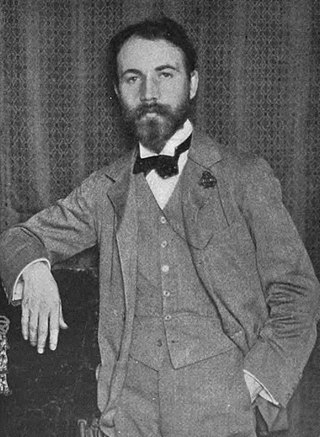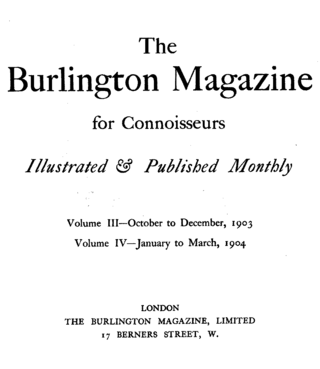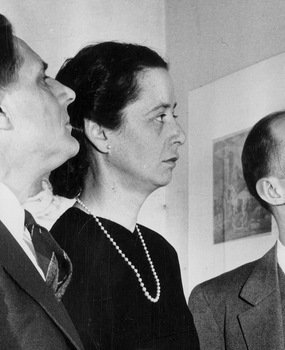
Roger Eliot Fry was an English painter and critic, and a member of the Bloomsbury Group. Establishing his reputation as a scholar of the Old Masters, he became an advocate of more recent developments in French painting, to which he gave the name Post-Impressionism. He was the first figure to raise public awareness of modern art in Britain, and emphasised the formal properties of paintings over the "associated ideas" conjured in the viewer by their representational content. He was described by the art historian Kenneth Clark as "incomparably the greatest influence on taste since Ruskin ... In so far as taste can be changed by one man, it was changed by Roger Fry". The taste Fry influenced was primarily that of the Anglophone world, and his success lay largely in alerting an educated public to a compelling version of recent artistic developments of the Parisian avant-garde.

Bernard Berenson was an American art historian specializing in the Renaissance. His book The Drawings of the Florentine Painters was an international success. His wife Mary is thought to have had a large hand in some of the writings.

The Burlington Magazine is a monthly publication that covers the fine and decorative arts of all periods. Established in 1903, it is the longest running art journal in the English language. It has been published by a charitable organisation since 1986.

The Courtauld Gallery is an art museum in Somerset House, on the Strand in central London. It houses the collection of the Samuel Courtauld Trust and operates as an integral part of the Courtauld Institute of Art.
John Kinder Gowran Shearman was an English art historian who also taught in America. He was a specialist in Italian Renaissance painting, described by his colleague James S. Ackerman as "the leading scholar of Italian Renaissance painting", who published several influential works, but whose expected major book on Quattrocento painting, for the Penguin/Yale History of Art series, never appeared. However, what is widely acknowledged as his most influential book, on the concept of Mannerism, published in 1967, is still in print.

Janet Cox-Rearick was an American art historian, Distinguished Professor of Art History at the City University of New York.
Caroline Arscott is an Emeritus Professor of the History of Art at the Courtauld Institute.
David Bindman is emeritus Durning-Lawrence professor of the history of art at University College London and has been a research fellow at the Hutchins Center for African & African American Research at Harvard University since 2010.
Howard Burns is a British architectural historian who is professor emeritus of architectural history at the Scuola Normale Superiore, Pisa. He has also lectured at the Courtauld Institute of Art and was Slade Professor of Fine Art at the University of Cambridge 1977-78. He is a specialist in the architecture of Andrea Palladio and is a member of the Accademia Olimpica and the Accademia di San Luca.
Deborah Janet Howard, is a British art historian and academic. Her principal research interests are the art and architecture of Venice and the Veneto; the relationship between Italy and the Eastern Mediterranean, and music and architecture in the Renaissance. She is Professor Emerita of Architectural History in the Faculty of Architecture and History of Art, University of Cambridge and a Fellow of St John's College, Cambridge.
Christopher Kenneth Green, is a British art historian, who was professor of the History of Art at the Courtauld Institute of Art between 1991 and 2008.
Marjorie Elizabeth Cropper is a British-born art historian with a special interest in Italian and French Renaissance and Baroque art and art literature. Dean of the National Gallery of Art’s Center for Advanced Study in the Visual Arts (CASVA) from December 2000 through May 2020, she previously held positions as Professor of Art History at Johns Hopkins University and director of the university’s Charles S. Singleton Center for Italian Studies at Villa Spelman in Florence.
Helen Hills is a British art historian and academic. She was appointed Anniversary Reader of Art History at the University of York in 2005 and promoted to Professor of History of Art in 2008, making her the first woman professor of Art History there.
Dillian Rosalind Gordon OBE is a British art historian who worked as a curator at the National Gallery, London from 1978 to 2010, latterly as Curator of Italian Paintings before 1460. She lives in Oxford. She was appointed OBE in 2011 for services to Early Italian Painting. She has authored and co-authored many books, including several National Gallery catalogues.
Eve Borsook was a Canadian-born American art historian, teacher and author, specialising in murals. Her other interests included the history of glass in relation to mosaics, 16th century Florentine ceremonial decoration, and Italian cloister art.
David Edward Hemsoll FSA is a British art and architectural historian, specialising in Renaissance art and architecture, especially that of Rome, Florence, and Venice. He has published numerous catalogue essays and books that address architectural theory and the methodology of architectural design. He is currently (2020) Senior Lecturer in the Department of Art History, Curating and Visual Studies at the University of Birmingham.
Julian Richard Gardner is a British art historian and Professor Emeritus at the University of Warwick. A scholar of late medieval and renaissance Italian art, particularly patronage, and a Giotto di Bondone specialist whose expertise has led to a number of scholarships and appointments as visiting professor at various institutions both in Europe and America.

The Dream of Ossian is an 1813 painting by the French artist Jean-Auguste-Dominique Ingres. The work depicts the legendary poet Ossian sleeping while he dreams of relatives, warriors and deities, which appear above him on the canvas. Ingres was influenced by his contemporaries' Ossianic works, including James Macpherson's purported translations of Ossian's poems, François Gérard's 1801 painting Ossian Evoking Phantoms, and Jean-François Le Sueur's 1803 opera Ossian, ou Les bardes.

Elizabeth Mongan was an art historian and curator, an authority on prints. She assembled the Rosenwald collection of prints and joined the National Gallery of Art as a curator when the collection moved there. She authored numerous exhibition catalogs, including the seminal The First Century of Printmaking, 1400 to 1500 and the catalogue raisonné of the prints of Paul Gauguin.
Caroline Campbell is an international art museum curator. Since November 2022, she is director of the National Gallery of Ireland, being the first woman taking this position in the Gallery’s 158 year history.






